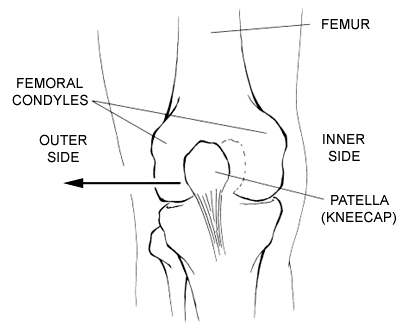
Synopsis
The patella, or kneecap, is one of three bones, along with the tibia (shin bone)
and femur (thigh bone), that make up the knee joint. All of these bones are
covered with a layer of cartilage at points where their surfaces come into
contact. Furthermore, the patella is enveloped by a tendon. This tendon connects
the quadriceps muscle of the thigh to the shin bone (tibia) below the knee.

The kneecap slides up and down a groove on the end of the femur as the knee
bends. This groove is called the patellofemoral articulation. The kneecap is
designed to fit in the center of this groove, and slide evenly within the
groove--this is called patellar tracking. In some patients, the kneecap is
pulled towards the outside of the knee. As this happens, the kneecap does not
track centrally within the groove.
Also called patellar subluxation, patients who experience an unstable kneecap have a patella that does not track evenly within its groove on the femur. Depending on the severity, this improper tracking may not cause the patient any problems, or it may lead to dislocation of the patella (where the kneecap fully dislocates out of joint). Most commonly, the tracking problem causes discomfort with activity, and pain over the edges of the kneecap. Patellar subluxation and dislocation are conditions that usually affects adolescents, and sometimes younger children.
Diagnosis and Treatment
There are several causes of patellar subluxation. This problem is usually
attributed the quadriceps muscle, specifically the vastus medialis obliquus (or
VMO). This muscle pulls the kneecap towards the middle of the knee joint,
maintaining its position in the joint. If this muscle is not as well developed
as other muscles around the knee, or if its muscle fibers are not adequately
oriented to control the kneecap, then patellar subluxation may result. The most
common cause of kneecap pain is chondromalacia, or an irritation of the
cartilage on the undersurface of the kneecap. Patellar subluxation and
chondromalacia can go hand in hand, but they should be considered separate
entities. That said, if chondromalacia is being caused by subluxation, then the
instability of the kneecap must be addressed for treatment to be successful.
Other causes of kneecap pain include osteoarthritis, patellar tendonitis
(Jumper's knee), and plica syndrome.
Treatment of the unstable patella is first to ensure that the patella is not dislocated. If it is, your doctor will need to properly 'reduce,' or reorient, the position of the kneecap. Early treatment of patellar subluxation includes:
Some patients are not cured by conservative therapy, and it may be determined
that surgery is needed, especially in patients who have significant pain or
recurrent dislocation. By looking into the knee with an arthroscope, the surgeon
can assess the mechanics of the knee joint to ascertain if there is an anatomic
malalignment that could be corrected. One common malalignment is the result of
too much lateral tension that pulls the kneecap out from its groove; this can
place increased pressure on cartilage and lead to dislocation. For this problem,
a procedure known as a lateral release can be performed. This procedure involves
cutting the tight lateral ligaments to allow the patella to resume its normal
position.